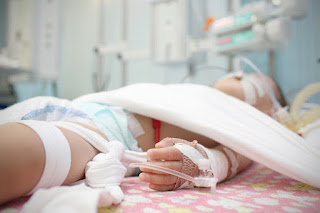 |
| Image: Bigstock |
Author: Shyam Sivasankar, MD
Emergency Medicine Resident
Stanford-Kaiser Emergency Medicine
AAEM/RSA Publications Committee Member
 |
| This post was peer reviewed. Click to learn more. |
I am very fortunate to train at a facility with a child life specialist present in the emergency department. Their presence has helped me learn a lot about running pediatric trauma surveys and resuscitations, and I have picked up a few pearls along the way. The following are some of their tips, tricks, and suggestions.
1. Calming Distractions
A trauma resuscitation can be quite overwhelming for an adult, let alone for a child. Use age appropriate interventions for each child including, but not limited to:
- Infants and Toddlers:
- Stuffed animals (for comfort)
- Bubbles (to encourage deep breathing and relaxation)
- Elmo Calls (Facetime™ with Elmo, a fun game for distraction)
- School Age/ Teens:
- iPads (or smart phones for distraction and teaching moments with patients)
- Simply Sayin’ (a smart phone application, created in part by Phoenix Children’s Hospital. This application provides illustrations, a free-draw option, and video clips to help both patients and their parents understand what is happening while simultaneously lowering the anxiety level in the room.)
- Stress ball for relaxation and stress management
- Deep breathing techniques to support relaxation
- Pandora radio (create a lullaby or piano/relaxation station that you can play to encourage relaxation and cooperation)
- Parental (caregiver) reassurance/support – if possible have the caregiver bedside throughout survey to help comfort and support the patient, if no caregiver is present, use an extra staff member to provide comfort measures and education.
- If child life is available, have them at the head of the bed. They will be able to work directly with the patient helping keep them calm and understand what is happening throughout the trauma survey.
2. Involve the caregiver(s)
Regardless of the situation, I have found it useful to form an early therapeutic alliance with the caregivers, hence putting the ‘Family Centered Care’ model into practice. [1] Family centered care is a model of care that intricately involves the family and patient in the planning, diagnostic, and therapeutic process. By creating a dialogue with the family and patient through information sharing and collaboration, the patient and his or her family is an active participant in the treatment process. This model is akin to shared decision making. Although caregivers may not be present immediately if the child was transported by EMS, it is useful to bring them into the room as early as possible and find a suitable location for them. If the airway is not a concern, it may be useful to have the parent at the head of the bed to help comfort the child.
Parents can be as overwhelmed as their child in the trauma bay. Get at least one parent involved early, and empower them with the responsibility of staying strong and helping their little one be at ease by talking with them during the resuscitation. For example, ask parents to help with your secondary survey such as by palpating their child’s abdomen to elicit a response from the patient that may be more reliable than if a stranger does the palpation.
3. Pain Control & Anxiolysis
Another adjunct to consider is pain control and anxiolysis. In the face of an already anxious child getting IV access, although sometimes necessary, is going to further intensify his or her level of stress. Thus, the IV route may not be the best route for pain control initially. Intranasal fentanyl at the dose of 2 mcg/kg can be used for those under 30 kg, and for those over 30 kg sufentanil can be used at a dose of 0.7 mg/kg intranasally. In addition, anxiolysis with intranasal midazolam may be useful at 0.4-0.5 mg/kg. [2]
- Intranasal medications
- If you need an IV, don’t surprise the patient. Use cold spray if possible and talk them through it. For example, “It will feel like a hug and then a pinch.”
- Encourage deep breathing — this helps esse pain: “Smell the roses and blow away the petals”
If you are fortunate enough to have child life specialists at your institution, utilize them, and learn from their experiences. Child life specialists, if present, are able to speak to children to help them cope and understand the primary and secondary surveys. It is never a bad idea to have a few extra tricks in your back pocket especially when it comes to pediatric trauma.
References:
1. Kuo DZ, Houtrow AJ, Arango P, Kuhlthau KA, Simmons JM, Neff JM. Family-centered care: current applications and future directions in pediatric health care. Matern Child Health J. 2012;16(2):297-305.
2. Wolfe TR, Braude DA. Intranasal medication delivery for children: a brief review and update. Pediatrics. 2010;126(3):532-7.
